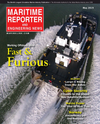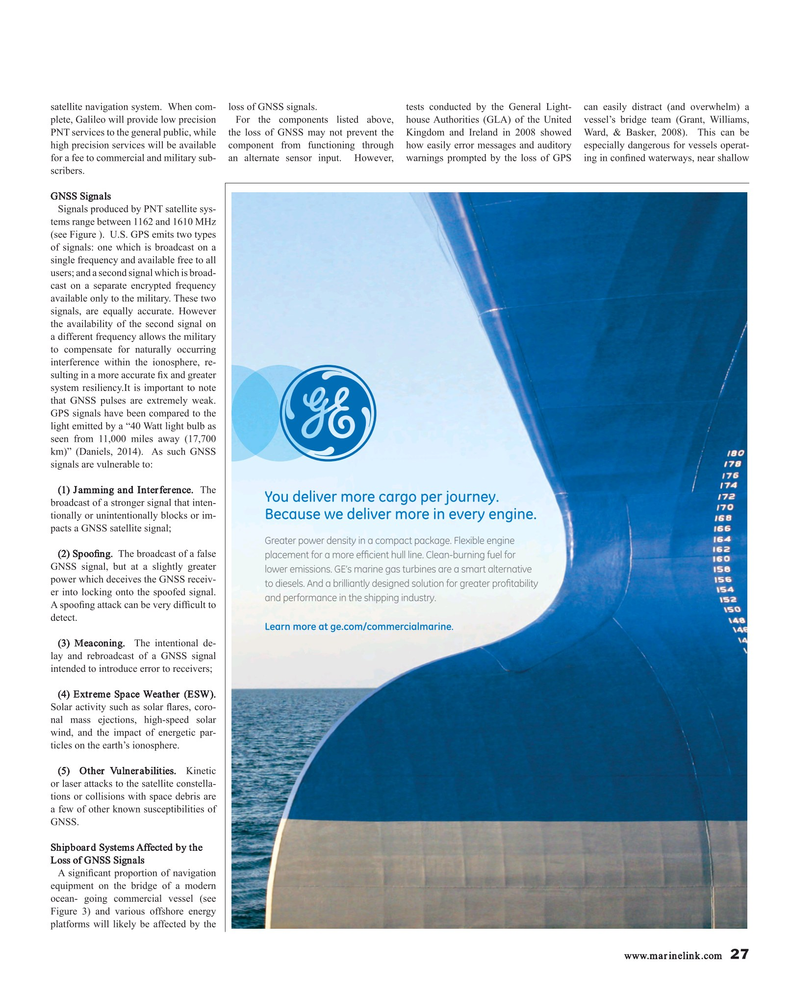
Page 27: of Maritime Reporter Magazine (May 2015)
The Marine Propulsion Edition
Read this page in Pdf, Flash or Html5 edition of May 2015 Maritime Reporter Magazine
satellite navigation system. When com- loss of GNSS signals. tests conducted by the General Light- can easily distract (and overwhelm) a plete, Galileo will provide low precision For the components listed above, house Authorities (GLA) of the United vessel’s bridge team (Grant, Williams,
PNT services to the general public, while the loss of GNSS may not prevent the Kingdom and Ireland in 2008 showed Ward, & Basker, 2008). This can be high precision services will be available component from functioning through how easily error messages and auditory especially dangerous for vessels operat- for a fee to commercial and military sub- an alternate sensor input. However, warnings prompted by the loss of GPS ing in con? ned waterways, near shallow scribers.
GNSS Signals
Signals produced by PNT satellite sys- tems range between 1162 and 1610 MHz (see Figure ). U.S. GPS emits two types of signals: one which is broadcast on a single frequency and available free to all users; and a second signal which is broad- cast on a separate encrypted frequency available only to the military. These two signals, are equally accurate. However the availability of the second signal on a different frequency allows the military to compensate for naturally occurring interference within the ionosphere, re- sulting in a more accurate ? x and greater system resiliency.It is important to note that GNSS pulses are extremely weak.
GPS signals have been compared to the light emitted by a “40 Watt light bulb as seen from 11,000 miles away (17,700 km)” (Daniels, 2014). As such GNSS signals are vulnerable to: (1) Jamming and Interference. The
You deliver more cargo per journey. broadcast of a stronger signal that inten- tionally or unintentionally blocks or im-
Because we deliver more in every engine.
pacts a GNSS satellite signal;
Greater power density in a compact package. Flexible engine (2) Spoo? ng. The broadcast of a false placement for a more ef? cient hull line. Clean-burning fuel for
GNSS signal, but at a slightly greater lower emissions. GE’s marine gas turbines are a smart alternative power which deceives the GNSS receiv- to diesels. And a brilliantly designed solution for greater pro? tability er into locking onto the spoofed signal. and performance in the shipping industry.
A spoo? ng attack can be very dif? cult to detect.
.
Learn more at ge.com/commercialmarine (3) Meaconing. The intentional de- lay and rebroadcast of a GNSS signal intended to introduce error to receivers; (4) Extreme Space Weather (ESW).
Solar activity such as solar ? ares, coro- nal mass ejections, high-speed solar wind, and the impact of energetic par- ticles on the earth’s ionosphere.
(5) Other Vulnerabilities. Kinetic or laser attacks to the satellite constella- tions or collisions with space debris are a few of other known susceptibilities of
GNSS.
Shipboard Systems Affected by the
Loss of GNSS Signals
A signi? cant proportion of navigation equipment on the bridge of a modern ocean- going commercial vessel (see
Figure 3) and various offshore energy platforms will likely be affected by the 81423_marine_hull_martm_jr.indd 1 3/17/15 2:46 PM www.marinelink.com 27
MR #5 (26-33).indd 27 MR #5 (26-33).indd 27 4/30/2015 10:28:34 AM4/30/2015 10:28:34 AM

 26
26

 28
28
